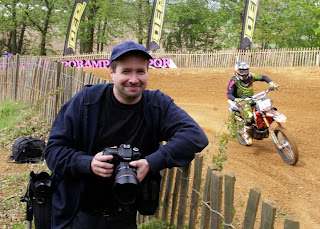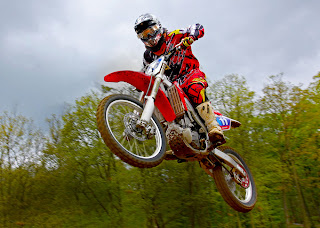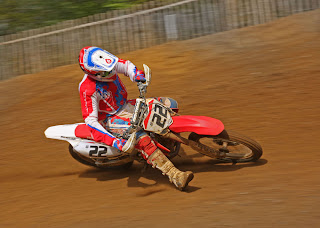Never having been to a motocross event before I my research and realised this was no ordinary motorsport event. The biggest difference for photographers was how close you could get to the riders compared to normal motorsport events. I don’t just mean in the pits, I mean the actual race itself.
.jpg) This photo of me should give you an idea of exactly how close to the track we really were. Incidentally this photo was taken by my good friend and awesome sports shooter Jonathan Munro. You can check out some of his shots from the day on his Flickr page.
This photo of me should give you an idea of exactly how close to the track we really were. Incidentally this photo was taken by my good friend and awesome sports shooter Jonathan Munro. You can check out some of his shots from the day on his Flickr page.
Although I applied for media credentials (I was hoping to shoot some photos and video for Digital Photo Magazine) the organisers weren’t forth coming, which made me a bit disappointed at the time. But the moment we got to the track I realised that I didn’t need a press pass to get unbelievably close to the racers.
We were so close to the action that we were regularly hit by the dirt thrown up by the bikes. The hat wan't a fashion statement but an essential item of clothing unless you want to spend the day picking mud out of your hair. It goes without saying that there is a very real risk to you’re your camera gear as well as your person.
I started the day using a Sigma 50-500mm lens I borrowed from Jonathan. It’s a monster long lens when wound right out to its full 500mm. The images looked excellent, but as we moved round the track we found ourselves getting closer and closer to the bikes and that long lens spent most of the day in my kit bag.
.jpg) Swapping to my favourite lens, the Canon 24-105L, proved to be a good decision. It’s a super sharp lens with swift focusing which was perfect for shooting the bikes that were whizzing past just a few meters or so in front of me. I also did something I’ve not done in a while… I spent the whole day shooting JPEG images.
Swapping to my favourite lens, the Canon 24-105L, proved to be a good decision. It’s a super sharp lens with swift focusing which was perfect for shooting the bikes that were whizzing past just a few meters or so in front of me. I also did something I’ve not done in a while… I spent the whole day shooting JPEG images.
.jpg) This photo of me should give you an idea of exactly how close to the track we really were. Incidentally this photo was taken by my good friend and awesome sports shooter Jonathan Munro. You can check out some of his shots from the day on his Flickr page.
This photo of me should give you an idea of exactly how close to the track we really were. Incidentally this photo was taken by my good friend and awesome sports shooter Jonathan Munro. You can check out some of his shots from the day on his Flickr page.Although I applied for media credentials (I was hoping to shoot some photos and video for Digital Photo Magazine) the organisers weren’t forth coming, which made me a bit disappointed at the time. But the moment we got to the track I realised that I didn’t need a press pass to get unbelievably close to the racers.
We were so close to the action that we were regularly hit by the dirt thrown up by the bikes. The hat wan't a fashion statement but an essential item of clothing unless you want to spend the day picking mud out of your hair. It goes without saying that there is a very real risk to you’re your camera gear as well as your person.
I started the day using a Sigma 50-500mm lens I borrowed from Jonathan. It’s a monster long lens when wound right out to its full 500mm. The images looked excellent, but as we moved round the track we found ourselves getting closer and closer to the bikes and that long lens spent most of the day in my kit bag.
.jpg) Swapping to my favourite lens, the Canon 24-105L, proved to be a good decision. It’s a super sharp lens with swift focusing which was perfect for shooting the bikes that were whizzing past just a few meters or so in front of me. I also did something I’ve not done in a while… I spent the whole day shooting JPEG images.
Swapping to my favourite lens, the Canon 24-105L, proved to be a good decision. It’s a super sharp lens with swift focusing which was perfect for shooting the bikes that were whizzing past just a few meters or so in front of me. I also did something I’ve not done in a while… I spent the whole day shooting JPEG images.OK, I know I bang on and on about shooting in RAW and I’ve not changed my opinion on the subject, but when it comes to shooting sports the shear volume of images I shot made shooting RAW an impossibility.
Some of my favourite images of the day were the panning shots. I really wanted to get this technique mastered and after a few hours practice I pretty much had it sorted so here’s how I did it.
.jpg) Practice the shot
Practice the shotI spent a couple of minutes watching the bikes go past and noting which line they took round a bend or along a straight. Next I’d practise the panning (without taking the shots) so I could be sure I had the zoom wide enough to capture the action all the way past me.
Background
As with most events there were plenty of advertising banners, spectators and marshals to distract from your photos so picking a good spot was vital.
Camera settings
I shot in Shutter Priority and settled on a speed of 1/125th of a second, which was slow enough to blur the background but fast enough to keep the biker sharp. I also used the cameras focus tracking and a single centre focus point to which I tried to keep locked on to the bikers helmet.
The reality
So how did I do? Well I shot around 3000 images (I couldn’t believe it when I got home) of which the vast majority are only good for the bin. I knew that would happen and I’m not worried, because when the photos worked they look fantastic.
I’ll defiantly be going back to Canada Heights again and who knows, next time I might even be able to work out who’s winning the races!















